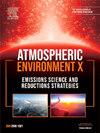Characterization of emissions from a turbojet engine running on sustainable aviation fuels, blends and conventional jet A1
IF 3.8
Q2 ENVIRONMENTAL SCIENCES
引用次数: 0
Abstract
Aviation contributes to air pollution and significantly impacts climate change. Sustainable aviation fuels (SAFs) offer a potential solution to reduce CO2 emissions with the possible co-benefit of reducing emissions of particles. This study evaluates emissions of a turbojet engine using conventional Jet A1 fuel, Biojet fuel (alcohol-to-jet synthetic kerosene with aromatics, ATJ-SKA), hydrotreated vegetable oil (HVO), and their blends. Emissions of particulate matter, gaseous pollutants (NOx, CO, total hydrocarbons, THC), polycyclic aromatic hydrocarbons (PAHs), volatile organic compounds (VOCs) and aldehydes were measured across different engine loads (Taxi, Cruise and Take-Off). The results show that SAFs, particularly neat Biojet and HVO, significantly reduced particle emissions, by 20 – >99 % compared to Jet A1, especially in the Take-Off mode in case of the Biojet fuel. This reduction is likely connected to the differences in the chemical composition of the fuels including higher content of hydrogen and lower content of aromatics and naphthalenes. Emissions of VOCs, PAHs and aldehydes were reduced by 40–50 % in the Taxi mode, which has the highest emission factors and is also responsible for majority of emissions during the LTO cycle, while an increase was observed for the Take-Off mode. Biojet use exhibited improved engine performance at the Take-Off, but fuel blends showed mixed effects on efficiency. This study shows that SAFs present a promising route to reducing aviation's environmental footprint, with co-benefit of reduced impact on air pollution and non-CO2 climate forcing from reduced particle emissions. Further research is required especially on impact of fuel blends on engine performance and emission characterization.

求助全文
约1分钟内获得全文
求助全文
来源期刊

Atmospheric Environment: X
Environmental Science-Environmental Science (all)
CiteScore
8.00
自引率
0.00%
发文量
47
审稿时长
12 weeks
 求助内容:
求助内容: 应助结果提醒方式:
应助结果提醒方式:


